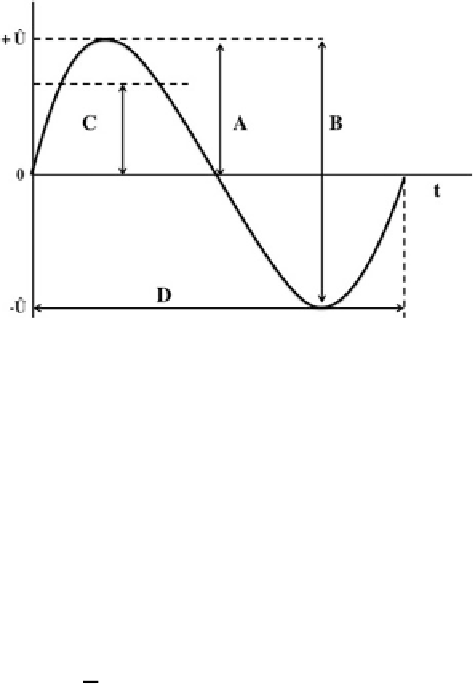Biology Reference
In-Depth Information
Fig. 9.3
Representation of
a sinusoidal curve and the
different way to measure
amplitude:
A
peak
amplitude (
U
),
B
peak-to-
peak amplitude (2
U
),
C
RMS (root mean
square) amplitude
¼
U
/
√
2,
D
wave period
t
temperature in
C,
S
(PSU)
where
c
¼
m/s is the speed of sound,
t
¼
¼
salinity,
and
D
(m)
depth.
The speed of sound in seawater increases with the increase of pressure (hence
depth),
¼
C ~ 4 m/s), and salinity (a change of
temperature (a change of 1
1 % ~ 1 m/s).
The speed of sound in water is about 4.5 times greater than in air for every
equifrequent sound.
9.2.1.6 Wavenumber
Wavenumber, defined as the reciprocal of the wavelength or also a spatial fre-
quency, is calculated by the formula
v
=λ
¼
1
.
9.2.1.7 Amplitude
Amplitude is the maximum amount by which the instantaneous sound pressure
differs from the ambient pressure. It is the dimension of the change in the oscillating
wave and can be measured as peak to peak, that is, the distance between two peaks
of a sinusoidal wave. Other ways to measure amplitude are
peak amplitude
(
ˆ
)
when a signal is not sinusoidal and the
root mean square
(RMS) amplitude, which is
the square root of the mean over time of the square of the vertical distance of the
graph from the rest state (Fig.
9.3
). The form of variation of amplitude is called the
envelope of the wave
.
For a sine wave the relationship between peak-to-peak and RMS is
Peak-to-peak
2
p
¼
RMS
U
¼
Peak
‐
to
‐
peak
2
substituting
in
the
above
equation
2
p
=
p
).
U
(
U
2
¼
2
RMS
then RMS
¼

Search WWH ::

Custom Search